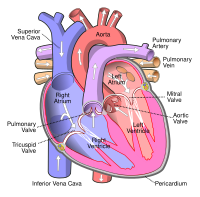
Photo from wikipedia
In the past decade, direct oral anticoagulants (DOACs) have proven to be the best option for patients with nonvalvular atrial fibrillation. Nevertheless, evidence for the use of DOACs for anticoagulation… Click to show full abstract
In the past decade, direct oral anticoagulants (DOACs) have proven to be the best option for patients with nonvalvular atrial fibrillation. Nevertheless, evidence for the use of DOACs for anticoagulation in valvular atrial fibrillation, particularly after aortic valve replacement, remains inadequate. Thus, we conducted a meta‐analysis to compare the efficacy and safety of vitamin K antagonists (VKAs) and DOACs in patients with atrial fibrillation after transcatheter aortic valve replacement (TAVR). We conducted a comprehensive search of online databases, and 11 studies were included in the final analysis. The primary endpoint was all‐cause mortality. Secondary endpoints included stroke and cardiovascular death. The safe endpoint is major and/or life‐threatening bleeding. Subgroup analysis was conducted according to the different follow‐up time of each study. Random‐effects models were used for all outcomes. Statistical heterogeneity was assessed using χ2 tests and quantified using I2 statistics. Patients in the DOACs group had a significantly lower risk of all‐cause mortality compared with patients in the VKAs group (relative risk [RR]: 1.20, 95% confidence interval [CI]: 1.01–1.43, p = .04). This benefit may be greater with longer follow‐up. In a subgroup analysis based on the length of follow‐up, a significantly lower risk of all‐cause mortality was found in the DOACs group in the subgroup with a follow‐up time of >12 months (RR: 1.50, 95% CI: 1.07–2.09, p = .001). There were no significant differences between the two groups in cardiovascular death, stroke, and major and/or life‐threatening bleeding. For patients with atrial fibrillation after TAVR, the use of DOACs may be superior to VKAs, and the benefit may be greater with longer follow‐up. The anticoagulant strategy for atrial fibrillation after TAVR is a valuable direction for future research.
Journal Title: Clinical Cardiology
Year Published: 2022
Link to full text (if available)
Share on Social Media: Sign Up to like & get
recommendations!